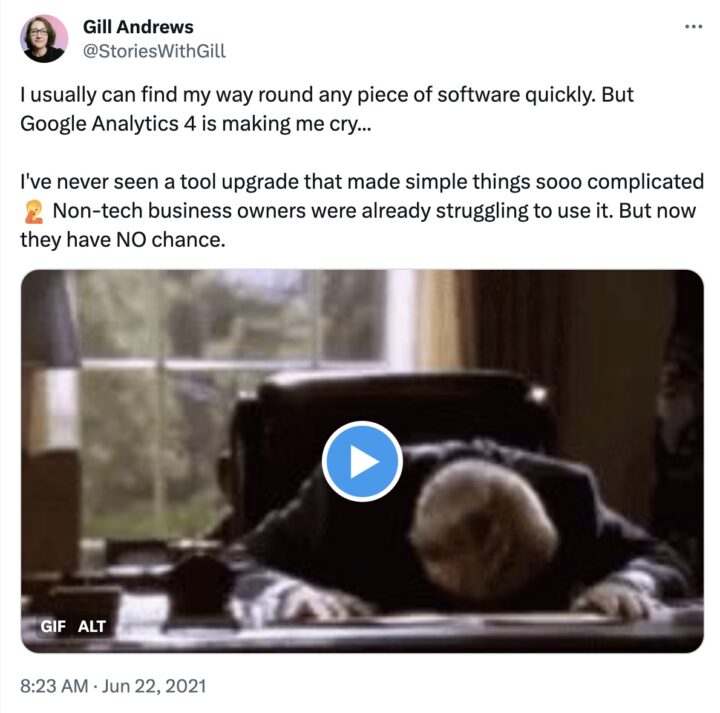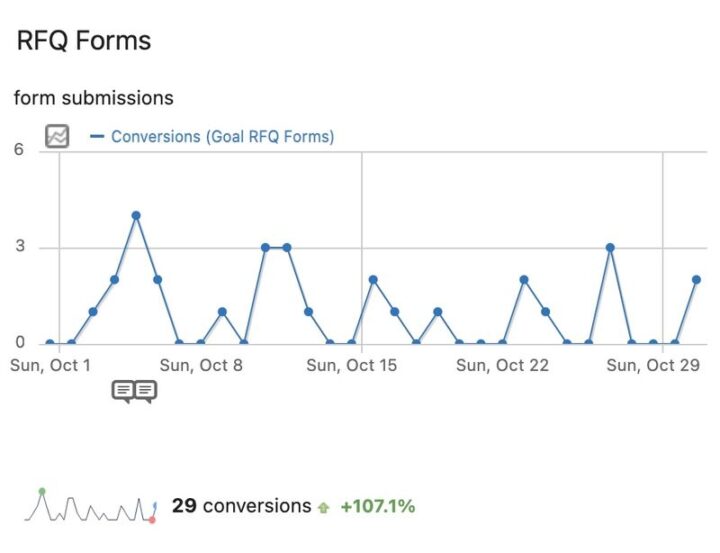I began using Urchin analytics in 2003 to track the SEO work I was doing for clients. Google purchased Urchin in 2005 and changed the name to Universal Analytics. My team and I used it for years and loved it.
At one point, I held an Analytics certification — back when the test was super tough and it took me a month to study for it and then pass. (I sweated bullets on that thing!)
In 2018, I began providing clients with simple conversion reports because I wanted to help them understand where their leads were coming from. I used UA and manually compiled the data from various reports.
(It had been a long-term goal of mine to provide my own insights to clients based on what I knew worked — versus relying on questionable data that’s often published by big companies.)
As new clients came on, they told me they loved these reports because they never had this kind of data before.
The more I analyzed data, the more I learned. I could also see my team and I were on to something — even more so when clients began sharing their sales wins with us. (Reading these emails always makes my day.)
The wrench in the works: GA4
In October 2020, Google announced its new Analytics platform, GA4. Universal Analytics would come to an end in June 2023. The problem? GA4 is TERRIBLE! It’s difficult to use, and because it uses predicative metrics (machine learning), it’s not applicable at all to smaller manufacturers’ unique data sets.
Worst of all, it was impossible to get the conversion data we needed in a usable format. The tweet pictured below sums up my experience with trying to learn how to use it.

After weeks of frustration, I began searching for alternatives and discovered Matomo Analytics, which I began trialing with our Ongoing Marketing clients in November 2022. We all loved it so much, I moved everyone over in May 2023.
Major upgrade to our Conversion Reporting
Also in 2023, we unveiled our new Conversion Report. A beautifully formatted spreadsheet, clients can now see at a glance where all their leads come from.
We created this report using Matomo and its API and expert coding by James Alavosus (my son). Conversion data is now automatically exported — saving us a ton of time by eliminating having to create manual reports.
One client immediately emailed to say, “I love this new format. Thank you HIM team!” Our pleasure. 😊
Since its unveiling, James has been instrumental in making continual updates to the report and the data we provide — including website visits from LinkedIn. 👀
What we track using Matomo
Depending on the client, their marketing program, and goals, we generally track the following:

- Form submissions: RFQs, Contact, Job Applications
- Events: Email and Phone clicks
- PPC conversions: We add Matomo URL parameters
- First click attribution: We compare apples to apples
The spreadsheet includes data tabs by month as well as a lead / ad spend summary for the current month and year.
A game changer
I share clients’ Conversion Reports with the entire HIM team; we all take pride in the success of our work and the results we get for clients. We also collaborate on how to continually improve performance.
My old boss, a world class sailor, once said, “You can’t rest on your past laurels. You have to go out and make new ones.”
That’s the philosophy by which I run Huff Industrial Marketing.
If this is the type of relationship you want with your marketing team, let’s have a conversation!
Filed under: Behind the Scenes
Rocky Update
Due to various combined circumstances, I injured my leg. Walking became incredibly painful. Not getting out for our walks sent me into a panic — which led me to a visit with our trainer.
He listened to me talk and then started asking questions: “Why are you taking Rocky to the neighbors for play sessions? How come you’re not throwing frisbees for him? What you’re doing is telling him they’re the cool kids — because they play with him — and you’re not.” Ouch.
Well, that was part of the problem. I have a fenced-in backyard, but it’s not large enough for him to run when I throw a frisbee or Chuckit! ball.
When I tried playing outside the fenced-in part, he’d carefully plot his moves and then make a mad dash for freedom: chasing after cats and squirrels or worse, motorcycles. The dog can go from zero to 60 in two seconds.
One day he ran across the road into my neighbor’s yard and did several zoomies: “I’m free! I’m free!” Part of me wanted to laugh; the other part was having a small heart attack because he could have been hit.
So, I fenced-in the side yard. He now has considerable run room — and after fifteen or so minutes of chasing sticks and balls, he plops on the ground panting, his big tongue hanging out. Yay!

He still has his weekly play date with the neighbor who throws frisbees, mostly because they both enjoy it, but I now have several frisbees in my yard, plus lots of Chuckit! balls. I stopped all his other play dates and the long multiple walks per day.
The biggest change, however, is me. I’ve had to learn to set boundaries. The trainer said, “By giving him attention on-demand, you’ve created a pest. You need down time. He needs to respect it.”
As with anything, it’s a work in progress, but we’re getting there. I can already see change. He’s a calmer and happier dog, and our bond has become stronger. We’re both having a really good time.




